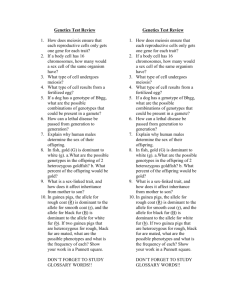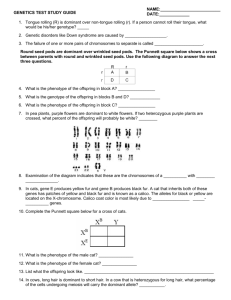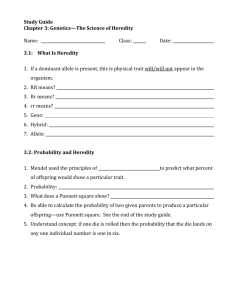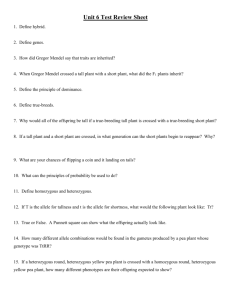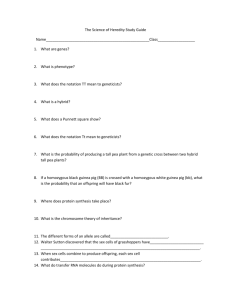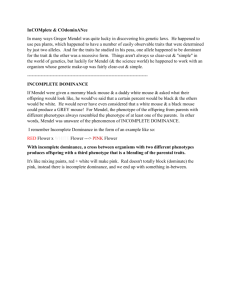Unit 6*Growth
advertisement
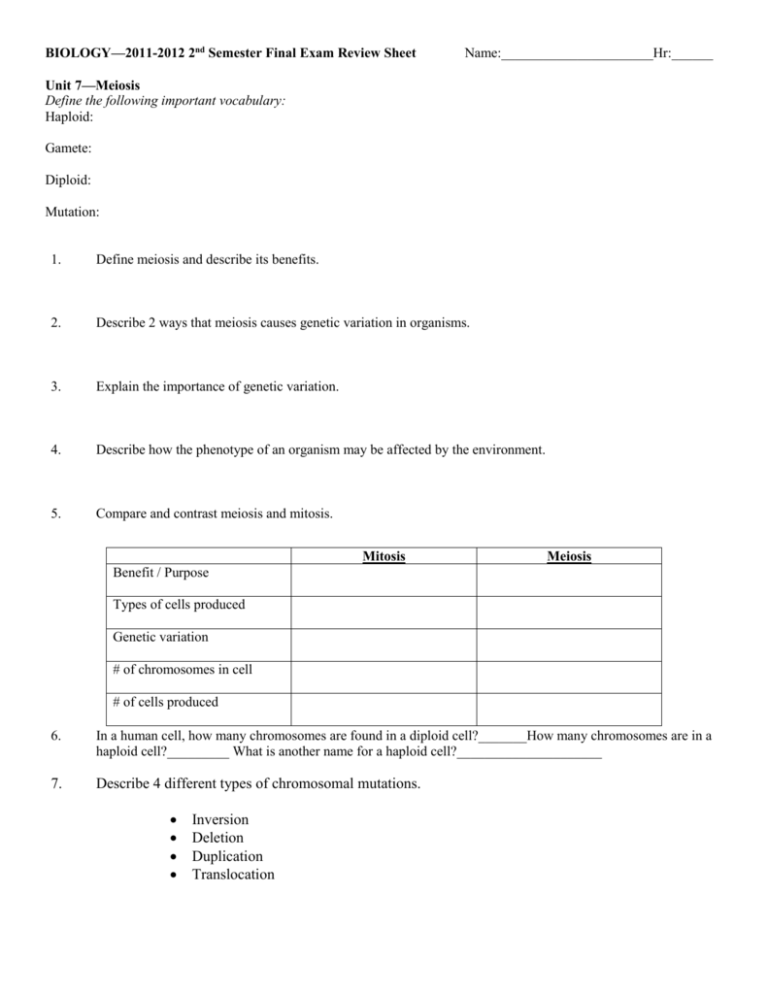
BIOLOGY—2011-2012 2nd Semester Final Exam Review Sheet Name:______________________Hr:______ Unit 7—Meiosis Define the following important vocabulary: Haploid: Gamete: Diploid: Mutation: 1. Define meiosis and describe its benefits. 2. Describe 2 ways that meiosis causes genetic variation in organisms. 3. Explain the importance of genetic variation. 4. Describe how the phenotype of an organism may be affected by the environment. 5. Compare and contrast meiosis and mitosis. Mitosis Meiosis Benefit / Purpose Types of cells produced Genetic variation # of chromosomes in cell # of cells produced 6. In a human cell, how many chromosomes are found in a diploid cell?_______How many chromosomes are in a haploid cell?_________ What is another name for a haploid cell?_____________________ 7. Describe 4 different types of chromosomal mutations. Inversion Deletion Duplication Translocation Unit 8 —Genetics Define the following important vocabulary: Recessive allele: Genotype: Dominant allele: Phenotype: Carrier/Heterozygous: Homozygous: Complete dominance: Multiple alleles: Incomplete dominance: Co-dominance: Sex-linked Inheritance: Autosomal Inheritance: 1. If given the phenotype and/or genotypes of parents, determine the genotypic and phenotypic ratio of possible offspring. And/or if given the genetic description of parents and offspring, determine the mode of inheritance. a. If orange is dominant over yellow in butterfly wing color, cross a heterozygous parent with a homozygous recessive parent. Use a Punnett square to determine the genotype and phenotype of the offspring. b. In Four O'Clock flowers, the allele for red flowers is incompletely dominant over the allele for white flowers. Let CR = red and CW =white. Any heterozygous offspring (CR CW) will have pink flowers Cross a homozygous red flowering plant with a pink flowering plant. Determine the phenotypic and genotypic ratios for the possible offspring. c. In shorthorn cattle red coat color is co- dominant to white coat color. Roan is the word used to describe the color of the cattle that are heterozygous for this trait. Roan cattle have intermixed read and white hairs. Cross a roan bull and a red cow. Determine the phenotypic and genotypic ratios for the possible offspring. d. If one parent has O type blood and the other has type AB, what are the possible blood types of the offspring? Use a Punnett square to determine the phenotypes. e. Hemophilia is a sex-linked trait on the X-chromosomes. Show a cross between a carrier mother and a dad who does not have the disease of hemophilia. a. What is the probability of having a child with hemophilia? b. What is the probability of having a child that is a carrier? c. Of the sons born, what is the probability of having a son that is a hemophiliac? 2. Explain why there is a 50% chance of having a male or female offspring. Which parent determines the sex of the child? Unit 9—Adaptation to the Environment (Evolution) Define the following important vocabulary: Evolution (Microevolution): Evolutionary theory (Macroevolution): Natural selection: Artificial selection: Adaptation: Speciation: 1. Identify and describe and the conditions necessary for natural selection to occur (4). Use peppered moths as an example. 2. Compare and contrast natural and artificial selection. Give examples of each. 3. Identify and describe and the conditions necessary for speciation to occur (3). 4. How does comparative DNA show evidence for evolution? 5. Why is variation desirable in populations? 6. Mark McGuire was nearly the biggest baseball player in the MLB at the time he retired. Will his son inherit his big muscles? Why or why not? a. Are McGuire’s muscles an adaptation? Explain b. Can a single organism change its genes? Explain c. Can a single organism evolve? Explain Unit 10—Interaction to the Environment – Ecology and Population Ecology Define the following important vocabulary: Producer: Consumer: Decomposer: Herbivore: Omnivore: Carnivore: Primary consumer: Secondary consumer: Tertiary consumer: Biological Magnification: Biome: Population: Community: Ecosystem: Carrying capacity: Biotic potential: Abiotic limiting factor: Biotic limiting factor: Exponential growth: Logistic growth: 1. Identify and explain the role of consumers, producers, and decomposers in food webs. 2. Define niche and habitat. Use the concept of niche and habitat in order to describe how organisms are able to coexist in an ecosystem. a. What happens when the niches for two organisms overlap? 3. Explain why species diversity is critical to food web stability. 4. Define symbiosis: 5. Describe the three types of symbiosis: a. Parasitism b. Commensalism c. Mutualism 6. Describe predator/prey relationships. 7. What is the source of energy for all ecosystems? 8. Explain the difference between how energy and matter flow/cycle in a food web. a. Place the following terms in order to best represent the movement of energy in an ecosystem: producers, sunlight, space (atmosphere), decomposers, consumers b. Place the following terms in order to best represent the movement of matter in an ecosystem: soil, producers, decomposers, consumers, producers again 9. Explain how some pollutants are biologically magnified in food webs. 10. Describe the importance of matter cycling through ecosystems, using carbon, water, and nitrogen as examples. a. Explain the role of photosynthesis and cellular respiration in the carbon cycle. b. How does water get from the oceans back to land? c. What role do bacteria play in the nitrogen cycle? 11. Explain how the carrying capacity of a species within an ecosystem is the balance between environmental resistance and biotic potential of a species. 12. Explain the significance of an S curve and a J curve in terms of population growth. 13. What type of growth curve shows logistic growth? What kind shows exponential growth? Which is an example of human growth? 14. Give and describe examples of biotic and abiotic limiting factors to population growth. 15. How are humans unique in their ability to influence limiting factors, affecting population growth? 16. What happens when you remove limiting factors? Will humans always be able to remove their limiting factors? Possible short answer topics Natural Selection Mitosis vs Meiosis Ecology Vocabulary Genetics Speciation


